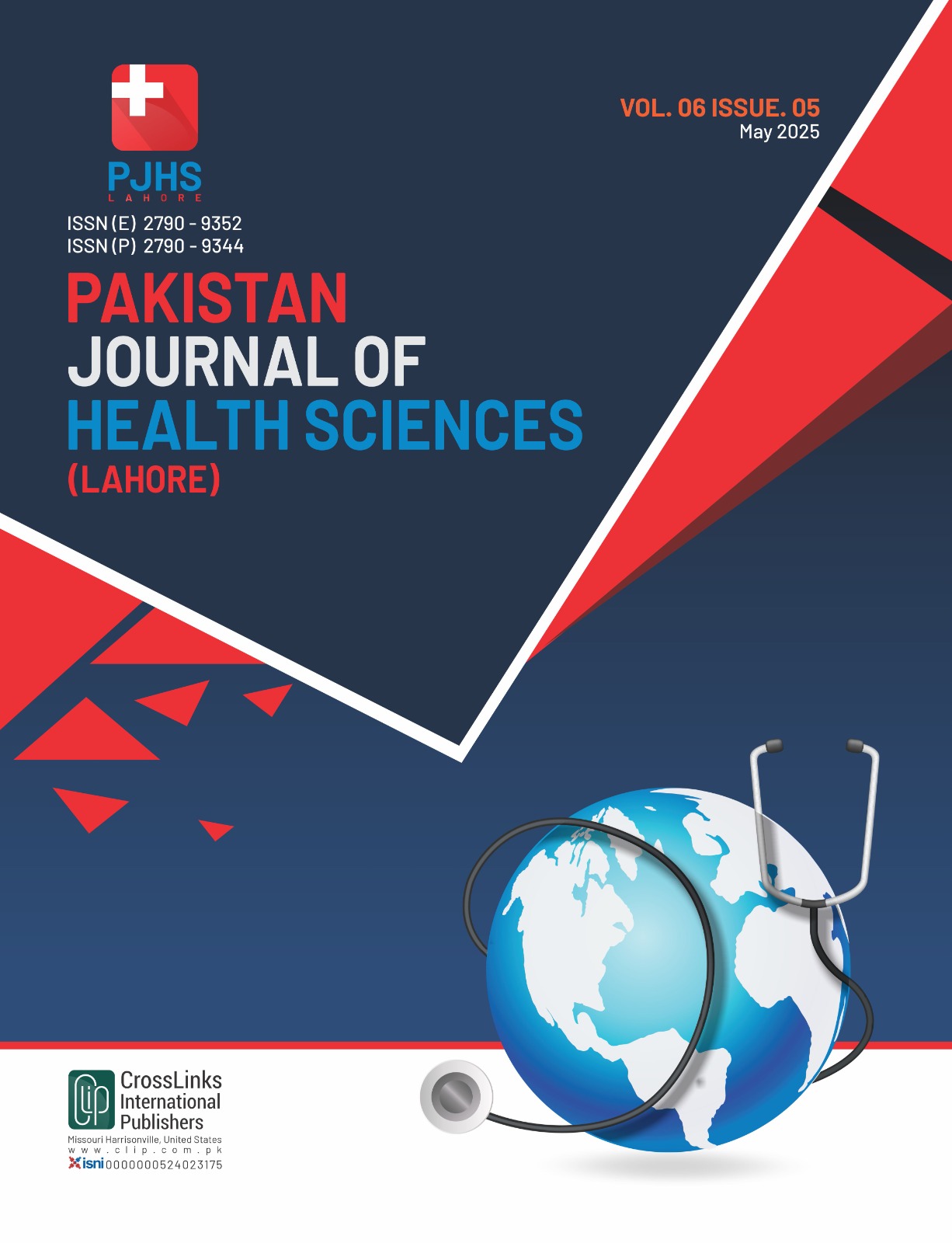Role of a Teacher in Medical Education: A Faculty’s Perspective from HBS
Role of a Teacher in Medical Education: A Faculty’s Perspective
DOI:
https://doi.org/10.54393/pjhs.v6i5.3090Keywords:
Medical Education, Faculty Perception, Teaching Methods, Innovative LearningAbstract
Medical educators are vital in delivering knowledge and shaping students' professional behaviour and critical thinking. However, their effectiveness is influenced by institutional support, teaching training, and the ability to adapt to innovative methodologies. Objectives: To assess faculty members' perceptions, teaching practices, and institutional involvement in medical education and to explore the association between formal training and innovative teaching methods. Methods: A descriptive cross-sectional survey was conducted at HBS Dental College, Islamabad, including 85 faculty members. Data were collected using a structured questionnaire covering demographics, teaching methods, perceptions of educational roles, and barriers faced. Statistical analysis was performed using SPSS version 25.0, applying Chi-square, Mann-Whitney U, and Kruskal-Wallis tests. Results: Lecture-based teaching was universal, while small group teaching (68.2%) and PBL (41.2%) were also common. Only 35.3% of faculty had formal training in medical education. A significant association was found between training and the use of innovative methods (p=0.001). Reflective teaching scores were higher among trained faculty (p=0.049). Lack of time was the most reported barrier (69.4%). Conclusions: It was concluded that faculty with formal training were more likely to adopt innovative and reflective teaching practices. Addressing institutional barriers and investing in structured faculty development can significantly enhance the quality of medical education.
References
Karami M, Hashemi N, Van Merrienboer J. Medical Educators’ Beliefs About Learning Goals, Teaching, and Assessment in the Context of Curriculum Changes: A Qualitative Study Conducted at an Iranian Medical School. BioMed Central Medical Education. 2021 Aug; 21(1): 446. doi: 10.1186/s12909-021-02878-3. DOI: https://doi.org/10.1186/s12909-021-02878-3
Sukkurwalla A, Zaidi SJ, Taqi M, Waqar Z, Qureshi A. Exploring Medical Educators’ Perspectives on Teaching Effectiveness and Student Learning. BioMed Central Medical Education. 2024 Dec; 24(1): 1433. doi: 10.1186/s12909-024-06465-0. DOI: https://doi.org/10.1186/s12909-024-06465-0
Shrivastava SR and Shrivastava PS. Challenges Encountered by Teachers in Medical Education. Journal of the Scientific Society. 2022 Jan; 49(1): 84-5. doi: 10.4103/jss.jss_153_21. DOI: https://doi.org/10.4103/jss.jss_153_21
van Lankveld T, Thampy H, Cantillon P, Horsburgh J, Kluijtmans M. Supporting a Teacher Identity in Health Professions Education: AMEE Guide No. 132. Medical Teacher. 2021 Feb; 43(2): 124-36. doi: 10.1080/0142159X.2020.1838463. DOI: https://doi.org/10.1080/0142159X.2020.1838463
Shin H and Kim MJ. Faculty development: the need to ensure educational excellence and health care quality. Kosin Medical Journal. 2023 Mar; 38(1): 4-11. doi: 10.7180/kmj.23.109. DOI: https://doi.org/10.7180/kmj.23.109
Slingerland M, Borghouts L, Laurijssens S, Eijck BV, Remmers T, Weeldenburg G. Teachers’ Perceptions of A Lesson Study Intervention as Professional Development in Physical Education. European Physical Education Review. 2021 Nov; 27(4): 817-36. doi: 10.1177/1356336X21997858. DOI: https://doi.org/10.1177/1356336X21997858
Bashir A and McTaggart IJ. Importance of Faculty Role Modelling for Teaching Professionalism to Medical Students: Individual Versus Institutional Responsibility. Journal of Taibah University Medical Sciences. 2022 Feb; 17(1): 112-9. doi: 10.1016/j.jtumed.2021.06.009. DOI: https://doi.org/10.1016/j.jtumed.2021.06.009
Shrivastava S, Manivasakan S, Shrivastava PS, Somu L. Perception of Faculty Toward Challenges in Teaching and the Role of Medical Education Workshops in Addressing Them: A Mixed-Methods Study. Avicenna Journal of Medicine. 2022 Jan; 12(01): 021-30. doi: 10.1055/s-0042-1744434. DOI: https://doi.org/10.1055/s-0042-1744434
AlAskari AM, Al Elq AH, Mohamed ER, Almulhem MA, Zeeshan M, Alabbad KA et al. Faculty Members’ Perception, Implementation, and Challenges of Formative Assessment in Undergraduate Medical Education: A Cross-Sectional Study. Cureus. 2024 Nov; 16(11). doi: 10.7759/cureus.74107. DOI: https://doi.org/10.7759/cureus.74107
Fernandes S, Araújo AM, Miguel I, Abelha M. Teacher Professional Development in Higher Education: The Impact of Pedagogical Training Perceived by Teachers. Education Sciences. 2023 Mar; 13(3): 309. doi: 10.3390/educsci13030309. DOI: https://doi.org/10.3390/educsci13030309
Nawabi S, Shaikh SS, Javed MQ, Riaz A. Faculty’s Perception of Their Role as A Medical Teacher at Qassim University, Saudi Arabia. Cureus. 2020 Jul; 12(7). doi: 10.7759/cureus.9095. DOI: https://doi.org/10.7759/cureus.9095
Qureshi SN, Khan RA. Challenges Faced by Faculty of Medical Education Due to the Structural Variation in its Departments across Medical Colleges. Pakistan Journal of Medical and Health Sciences. 2023 Feb; 17(01): 148-. doi: 10.53350/pjmhs2023171148. DOI: https://doi.org/10.53350/pjmhs2023171148
Catanzano T, Deitte LA, Naeger DM, Morgan DE, Germaine P, Slanetz PJ. Meeting Faculty Development Needs: Review of Current Resources and Opportunities for Program Development. Academic Radiology. 2022 Jul; 29(7): 1116-23. doi: 10.1016/j.acra.2021.08.021. DOI: https://doi.org/10.1016/j.acra.2021.08.021
Hennessy S, D'Angelo S, McIntyre N, Koomar S, Kreimeia A, Cao L et al. Technology Use for Teacher Professional Development in Low-and Middle-Income Countries: A Systematic Review. Computers and Education Open. 2022 Dec; 3: 100080. doi: 10.1016/j.caeo.2022.100080. DOI: https://doi.org/10.1016/j.caeo.2022.100080
Widayati A, MacCallum J, Woods-McConney A. Teachers’ Perceptions of Continuing Professional Development: A Study of Vocational High School Teachers in Indonesia. Teacher Development. 2021 Oct; 25(5): 604-21. doi: 10.1080/13664530.2021.1933159. DOI: https://doi.org/10.1080/13664530.2021.1933159
Challa KT, Sayed A, Acharya Y. Modern Techniques of Teaching and Learning in Medical Education: A Descriptive Literature Review. MedEdPublish. 2021 Jan; 10: 18. doi: 10.15694/mep.2021.000018.1. DOI: https://doi.org/10.15694/mep.2021.000018.1
Hathur B and Kulkarni P. Changing Roles of Medical Teachers in the Era of Competency-Based Medical Education. Association of Physicians of India, Karnataka Chapter Journal of Internal Medicine. 2024 Jan; 12(1): 1-3. doi: 10.4103/ajim.ajim_100_23. DOI: https://doi.org/10.4103/ajim.ajim_100_23
Hanson ER, Gantwerker EA, Chang DA, Nagpal AS. To Teach or Not to Teach? Assessing Medical School Faculty Motivation to Teach in the Era of Curriculum Reform. BioMed Central Medical Education. 2022 May; 22(1): 363. doi: 10.1186/s12909-022-03416-5. DOI: https://doi.org/10.1186/s12909-022-03416-5
Wisniewski B, Röhl S, Fauth B. The Perception Problem: A Comparison of Teachers’ Self-Perceptions and Students’ Perceptions of Instructional Quality. Learning Environments Research. 2022 Oct; 25(3): 775-802. doi: 10.1007/s10984-021-09397-4. DOI: https://doi.org/10.1007/s10984-021-09397-4
Ahmad N, Ali Z, Saba F, Yaqoob N, Ullah N. Teachers’ Perceived Knowledge of Self-Concept and Its Influence on Their Teaching Practices. International Journal of Multicultural Education. 2023; 25(2): 152-66.
Downloads
Published
How to Cite
Issue
Section
License
Copyright (c) 2025 Pakistan Journal of Health Sciences

This work is licensed under a Creative Commons Attribution 4.0 International License.
This is an open-access journal and all the published articles / items are distributed under the terms of the Creative Commons Attribution License, which permits unrestricted use, distribution, and reproduction in any medium, provided the original author and source are credited. For comments













